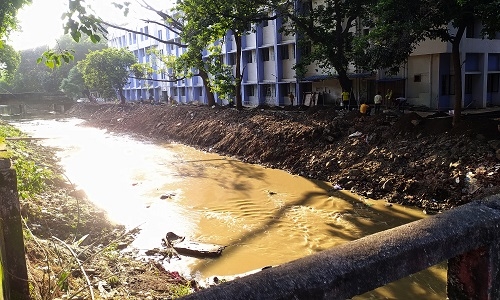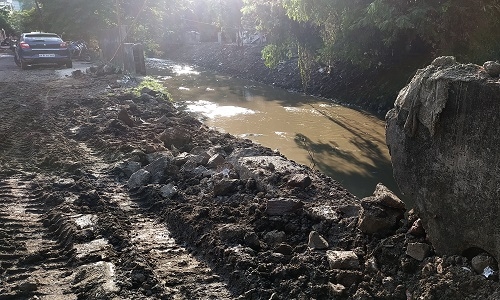‘Irreversible blunder’ - Nagpur’s fate ??
| Date :27-Sep-2023 |

By Kaushik Bhattacharya
THE havoc created by the flash floods on September 23 has laid bare many claims and faults engineered by the civic administration and the political leadership in the name of beautification and development. Questions are being raised over the monsoon preparedness and flood management even as the city counts a heavy price of the disaster, clearly aided by man-made factors. Being a People’s Paper, ‘The Hitavada’ probed the reasons behind the flash floods and the mitigation measures, if any. The investigation has revealed multiple factors that conclude that the blunders caused by poor planning are irreversible. It has led to a pricking query -- is this the fate of the city of Nagpur? Faulty designs, bad urban planning and a lethargic civic administration have emerged as the prime reasons behind the flood havoc. Deputy Chief Minister of Maharashtra Devendra Fadnavis also agreed to the fact when, during a visit to the flood-affected areas, he stated, “We could have minimised the damage if some measures were taken earlier.” ‘The Hitavada’ investigation brought to fore many loopholes near the Ambazari Lake, the city’s largest water body, whose boundaries were breached last Saturday due to heavy rains. The faults could have been addressed not only by the administration but also by the structural engineers to avoid a flood-like situation. However, precious little was done as apathy took over the decision-making process.
When this reporter spoke to city-based structural engineers, hydrologists, geological scientists and architects as part of the investigation, all of them raised serious concerns over the ongoing haphazard development by ignoring city’s hydrology. “It was a man-made disaster which is irreversible. The way we are ignoring the hydrology of the city in the name of development, such floods will happen in future also,” Paramjit Singh Ahuja, eminent Practising Architect, PSA Design Studio, told ‘The Hitavada’. “Every development in the city is without any hydraulic map. Even the ambitious Nagpur Metro project is implemented without hydraulic study. The contour map is essential for any structural design to study the water evacuation in case of rains like these. Unfortunately, Nagpur city has no such plan,” claimed Ahuja. “You can’t rely on storm-water drains when you already encouraged the traditional sources of water evacuation and percolation in city. For example, there is no need to construct storm-water drains on the slope of University Campus where the water can automatically find its way to low-lying areas,” said Ahuja. “Every dam must have open space for water evacuation. But the Vivekanand Memorial at the overflow side of Ambazari Lake is posing threat as it is obstructing the water flow during a flood-like situation,” he added. Sandeep Shirkhedkar, eminent Structural Engineer and Hydrology Consultant of Nagpur, said, “The recent flood took place due to heavy rains in the catchment area of Ambazari lake. The flow of excess water crossed the overflow point of the lake and moved further to Naag River.

You can notice that the flood water first damaged the bridge near the lake itself and then it damaged the bridge near Panchsheel Square.” Most of the bridges on Naag River were constructed during British era and all of them have already crossed their expected life. The space under these bridges is very narrow and it was not made to handle such a huge amount of water during monsoon. During the recent flood the space failed to handle the water flow and the flood water found its way into residential areas, added Shirkhedkar. “The lack of maintenance and proper cleaning of garbage under the bridges is also a major reason behind this flood. It is the main reason behind collapse of Panchsheel Square bridge during the recent flood,” he said. Shirkhedkar also said, the Vivekanand Memorial is a major cause of flood because it is obstructing the water flow of the lake at the time of heavy rains. “Along with desilting of Naag River there is an utmost need of widening of the river to handle such floods in future. Due to encroachment and haphazard development in city we lost all tributaries of Naag River. There is no natural nullah left in Naag River that helps to spread the flood water during heavy rains,” said the Hydrology Consultant. According to Dr Anjan Chatterjee, ex-Additional Director General, Geological Survey of India (GSI), “The tonnes of garbage, industrial waste, human non-biodegradable and organic waste compounded by unscientific civil structures impaired the seamless flow of all vulnerable rivers flowing across the city that have aided this disaster.”
Eichhornia weeds at the provenance of the Ambazari Lake and also in the Naag River aggravated the problem. “The normal discharge of surface rain water to subsurface aquifers unhindered has been severely been impaired by the cement roads, unscientific but licensed and/or illegal civil structures which were also culprits and are likely to be massive bottlenecks. These have the potential to cause immense loss of lives and property in future,” said the Geologist.
“A scientific study needs to be conducted by an accreditated institution and mitigation measures suggested thereafter need to be immediately acted upon, without interference from the non-scientific entities, many of whom have personal and non-social agendas,” Dr Chatterjee added. “Infrastructure development is need of the hour but the city fathers must know the importance of the city’s environment. Nagpur is developing fast but the administration has ignored sustainable development and this flood is an eye-opener for all of us,” Shrikant Doifode, retired Assistant Chief Engineer, Water Resources Department said. “In the name of development, we lost our natural sources of water that connects our Naag River. As a result, the river is just consuming sewage through drainage lines connected with the water body,” he further said. The retired Chief Engineer also blamed the spot of the Vivekanand Memorial which is proving a major obstruction to flood water. “The recent flood took place due to heavy rains in Wadi area which is adjoining the catchment of Ambazari Lake. The Vivekanand Memorial obstructed the flood water due to which it spilled over the residential areas,” Doifode claimed. All the observations had been raised time and again by the media while warning of a major natural disaster. Yet, all of them seem to have fell on deaf ears. This non-chalance has now put the fate of Nagpur city at stake.